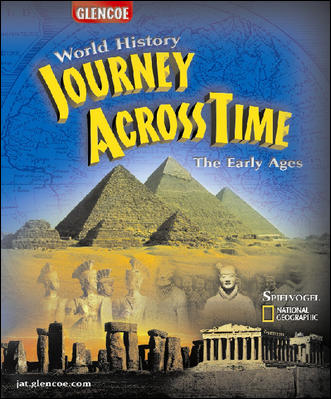
Journey Across Time: The Early AgesChapter 16: The AmericasChapter OverviewsDuring the Ice Age, much of the earth's water was frozen into glaciers. This exposed a land bridge called Beringia. Scientists and historians believe that people in Asia crossed this bridge while hunting animals, and they became the first people to inhabit the Americas. The first Americans were hunter-gatherers, but the people of Mesoamerica discovered farming. This important discovery led to the rise of civilizations in the Americas. The Mesoamerican civilizations included the Olmec, Maya, and Toltec. South of these Mesoamerican civilizations, the Moche and Inca thrived. The Maya thrived in Guatemala's dense rain forests and took advantage of their homeland's large system of underground rivers and streams. The Maya organized into city-states and built a culture based on their religious beliefs. They made many contributions to society, developing a 365-day calendar, a system of mathematics based on the number 20, and a written language using a system of hieroglyphics. The Aztec were nomadic warriors who moved into the Valley of Mexico and created an empire based on the conquest of war. A council of warriors, priests, and nobles chose a king to rule the empire. The glories of war and civic duties were very important to the Aztec. To unite their huge empire, Incan rulers set up a highly organized government and society. The Inca built large works of stone to please their gods. In order to build these structures, they used a quipu to perform mathematical calculations. The geography of North America shaped the development of many different Native American cultures. These Native Americans adapted to their varied environments. The Inuit settled in the Arctic, where they lived in igloos to battle frigid temperatures. The Pacific Northwest was heavily populated, as different groups enjoyed the region's rich food resources. The people who settled in the Southwest used irrigation systems to farm dry land and lived in homes made of adobe. The Native Americans who settled the Great Plains hunted buffalo for food, tools, clothing, and shelter. The groups that inhabited the Eastern Woodlands hunted, fished, and farmed. Many of these groups formed governments, and some, like the Iroquois, even established a confederation to bring peace to their people. An Italian explorer named Christopher Columbus accidentally discovered the Americas while trying to find a sea route to Asia. He landed on an island in the Caribbean in 1492. Spanish conquistadors claimed the discovered lands for their country, marking Spain's presence in the Americas. Columbus's success inspired others to explore the world outside of Europe and seek fortune in South America. Hernán Cortés invaded Mexico and defeated the Aztec using guns, horses, and disease. Another Spanish explorer named Francisco Pizarro found and conquered the Inca in Peru. |  |















